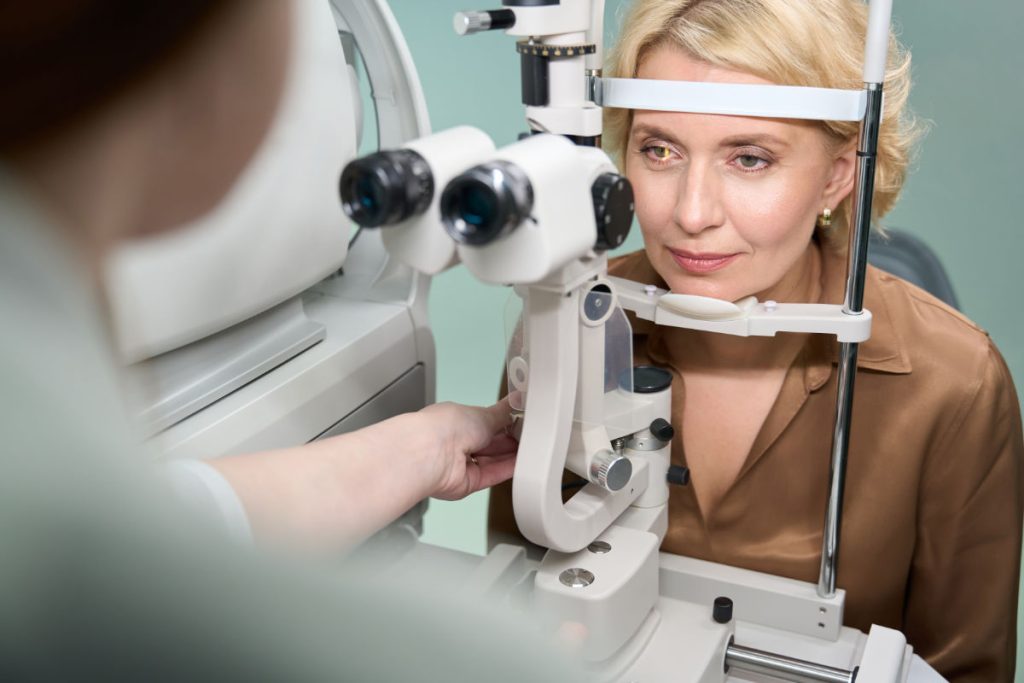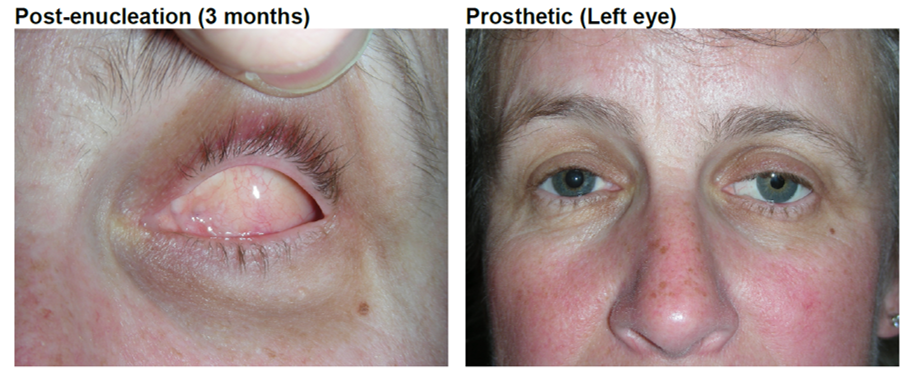
Why is evisceration or enucleation necessary?
Evisceration is the surgical removal of the contents of the eyeball, leaving the white ‘shell’ of the eye (sclera) and the eye muscles intact.
Enucleation is the surgical removal of the entire eyeball. Nothing is left behind apart from the muscles that move the eye. An enucleation is the preferred procedure to remove an eye tumour or if your eye was injured due to trauma.
There are several reasons why an eye or its contents are removed, for example to treat a painful blind eye, to treat certain eye tumors or severe eye injuries, to alleviate a severe infection inside the eye, or for cosmetic improvement of a disfigured and blind eye.
The eye is only removed if all other suitable treatments have been tried and have failed. Sometimes this involves consulting other ophthalmologists.
What does evisceration or enucleation involve?
Both surgeries are usually performed in the operating room under general anesthesia. They may also be safely performed using local anasthetic with sedation, The operation takes about 90 minutes.
After enucleation or evisceration, a ball implant is usually placed in the eye socket to replace some of the volume lost.
This implant is a sphere made of heat treated ocean coral, aluminum oxide, silicone or plastic. This implant will be covered by your own eye socket lining (conjunctiva), giving a pink appearance.
After an evisceration, the contents of the eye are removed, leaving the sclera or white shell of the eye intact. The ball placed inside the sclera, with the muscles still attached to the sclera as normal.
After enucleation, the eyeball is removed but the muscles that move the eye are left behind. These muscles can be reattached directly to the ball implant to preserve some eye movement.
Sometimes a conformer (a clear, plastic shell) is put in place behind the lids while the socket heals
What are the potential risks?
Short-term risks, as with any surgery, include
● Bleeding● Swelling
● Infection
Long-term risks include:
● Discharge● Socket irritation
● Exposure of the ball implant. This may require further surgery to treat.
What can I expect?
Before surgery:
Blood thinning medications such as aspirin, clopidrogel (Plavix, Iscover) and warfarin can make bleeding more likely during and after surgery. If you are taking these medicines, you will be told if and when to stop them prior to surgery surgery.
You should also stop anti-inflammatory drugs like ibuprofen (Nurofen) and supplements containing fish oil, ginger, ginseng and garlic 2 weeks before surgery.
If you smoke it is strongly recommended that you stop smoking for at least 3 days prior and 1 week after surgery. This is important as smoking impairs wound healing and increases the risk of infection.
Avoid alcohol for a day before and a day after surgery.
If you are having sedation or general anesthetic, please fast and have nothing to eat or drink for at least 6 hours before surgery.
On the day of surgery, please dress casually and wear a top which buttons at the front. Please wash your face on the morning of surgery and ideally men should shave.
Do not wear any makeup, jewellery or contact lenses.
On the day of surgery we mark your forehead with your consent to indicate which eye is to be removed.
After surgery:
You go home the same day or you can stay in overnight especially if you live alone or if you have a long journey home. It is advisable to be driven home by a friend or relative and not to travel home on public transport. You must not drive yourself.
The eyelids can be stitched closed to prevent too much swelling. This stitch is removed in the eye clinic a week or two after surgery.
The eye is usually covered with a pad for up to a week afterwards.
You can clean the lids with cool, boiled water to remove any mucus. You may need to take antibiotic, pain relief, and anti-inflammatory.medications.
Continued follow-up is important to check the eye socket lining for any signs of thinning, shrinkage, or exposure of the ball implant. There may also be a gradual loss of volume in the eye socket which can affect the fit of the prosthesis.
Careful monitoring of the socket and prosthesis by the ophthalmologist and the prosthetist will help keep the socket healthy, and will allow for early detection of any changes that might require further treatment.
For 1 week after surgery, please avoid strenuous exercise, running, or heavy lifting (> 5kg) for a week. You also cannot drive, operate machinery, drink alcohol or take sedative drugs for 24 hours.
You can wash and shower normally but avoid a very hot shower or bath in the first week. Do not swim for 2 weeks.
Please avoid touching the eye socket itself.
In general, it is recommended to take at least 2 to 3 weeks off work to recuperate and return to work only when ready.
Assuming that you have normal vision in the other eye, you can drive when you feel ready the next day, providing the vision in the remaining eye meets the legal requirements for driving.
What will the eye look like in the long term?
Once the eye socket has healed, about 6-8 weeks after your surgery, an artificial eye (prosthesis) will be made by an ocular prosthetist (also known as an ocularist).
The front surface of the artificial eye is custom painted to match the other eye. The back surface is molded to fit the socket for comfort and movement.
Additional connections can be made at a later date to provide greater movement of the prosthesis. This procedure carries its own set of risks and should be discussed with your surgeon.

How should I look after my prosthesis (artificial eye)?
Most patients sleep with the prosthesis in place and remove occasionally for cleaning as necessary.
It is easily removable, like a large contact lens.
A prosthesis can last decades in many patients.


